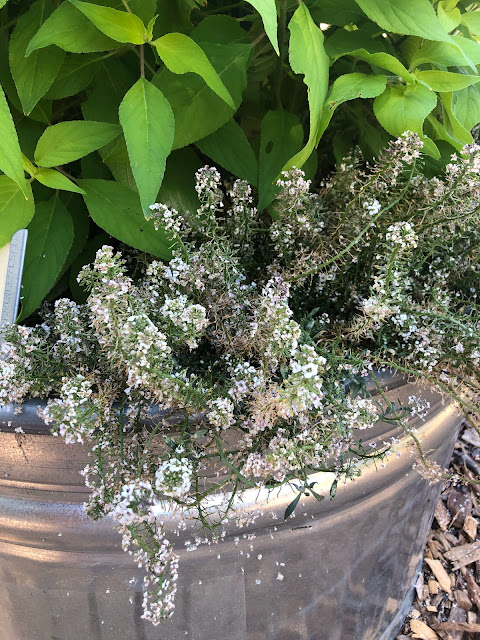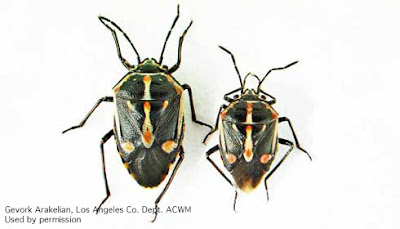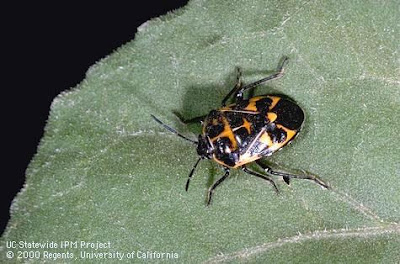
Bagrada bugs and other nasties can sneak into gardens

|
|
At the Fair Oaks Horticulture Center's Herb Garden,
the sweet alyssum was on its way out and now it's gone.
(Photo: Kathy Morrison)
|
Sweet alyssum produces a lovely cloud of white blossoms in any flower bed. In the Herb Garden of the Fair Oaks Horticulture Center this summer, it surrounded a beautiful 'Golden' pineapple sage.
That latter sentence is past tense because this morning I pulled out all the alyssum in the container, as well as the two clumps that were growing in a raised bed nearby.
Why yank them out? Well, it's getting to be fall planting season, and soon the FOHC's Vegetable Garden crew will be planting their brassicas -- cool-weather cole crops that include cauliflower, cabbage, kale, turnips and mustard greens. Alyssum also is part of that family.
You know which pest is attracted to brassicas? The bagrada bug, a nasty stink bug that was first seen in Southern California about 2008 and has spread north since.
The alert to the Herb group went out from master gardener/vegetable expert Gail Pothour -- she'd been checking around and under our lush alyssum for offenders. So far she'd only seen harlequin bugs (more about those in a minute) but the concern was there.
So there's no point making the vegetable gardeners' job harder: Out went the alyssum.
Those of us who mostly grow summer vegetables are accustomed to battling aphids, tomato hornworms, spider mites and leaf-footed bugs. But even though the weather's still very warm, fall planting plans have to include prevention of the pests of cool-weather crops.

|
|
Bagrada bugs are only 1/4-inch long; the female
is larger than the male. (Courtesy UC IPM)
|
In addition to monitoring or removing potential host plants, including weeds, the gardeners also put floating row covers on hoops over the vegetable seedlings. This is to deter those little butterflies you see in the fall from laying eggs on the plants. Those eggs grow into cabbageworms (white butterflies) and cabbage loopers (brown moths), which will skeletonize the leaves given the chance.

|
|
The harlequin bug is 3/8-inch long and is brightly colored.
(Courtesy UC IPM) |
If you find bagrada, harlequin or other stink bugs in the garden, handpicking is the easiest way to handle them. Don't squish them -- there's a reason they're called stink bugs. Instead, knock them into a bucket of soapy water. And keep a close watch for additional invaders; they can multiply quickly. Your fall and winter crops depend on your vigilance.
Comments
0 comments have been posted.Sacramento Digs Gardening to your inbox.
Sites We Like
Garden Checklist for week of May 12
Get your gardening chores and irrigation done early in the day before temperatures rise.
* Plant, plant, plant! It’s prime planting season in the Sacramento area. Time to set out those tomato transplants along with peppers and eggplants. Pinch off any flowers on new transplants to make them concentrate on establishing roots instead of setting premature fruit.
* Direct-seed melons, cucumbers, summer squash, corn, radishes, pumpkins and annual herbs such as basil.
* Harvest cabbage, lettuce, peas and green onions. This heat will cause leafy greens and onions to flower; pick them before they bolt.
* In the flower garden, direct-seed sunflowers, cosmos, salvia, zinnias, marigolds, celosia and asters.
* Plant dahlia tubers. Other perennials to set out include verbena, coreopsis, coneflower and astilbe.
* Transplant petunias, marigolds and perennial flowers such as astilbe, columbine, coneflowers, coreopsis, dahlias, rudbeckia and verbena.
* Keep an eye out for slugs, snails, earwigs and aphids that want to dine on tender new growth.
* Feed summer bloomers with a balanced fertilizer.
* For continued bloom, cut off spent flowers on roses as well as other flowering plants.
* Got fruit trees? If you haven't already done so, thin orchard fruit such as apples, peaches, pears, pluots and plums before they grow too heavy, breaking branches or even splitting the tree. Leave the largest fruit on the branch, culling the smaller ones, and allow for 5 to 6 inches (or a hand's worth) between each fruit.
* Thin grape bunches, again leaving about 6 inches between them. For the remaining bunches, prune off the "tail" end, about the bottom third of the bunch, so that the plant's energy is concentrated in the fruit closest to the branch.
* As spring-flowering shrubs finish blooming, give them a little pruning to shape them, removing old and dead wood. Lightly trim azaleas, fuchsias and marguerites for bushier plants.
* Add mulch to the garden to help keep that precious water from evaporating. Mulch also cuts down on weeds. But don’t let it mound around the stems or trunks of trees or shrubs. Leave about a 6-inch to 1-foot circle to avoid crown rot or other problems.